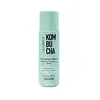What's inside
What's inside
 Key Ingredients
Key Ingredients

 Benefits
Benefits

 Concerns
Concerns

 Ingredients Side-by-side
Ingredients Side-by-side

Water
Skin ConditioningDecyl Glucoside
CleansingSodium Cocoyl Isethionate
CleansingCocamidopropyl Betaine
CleansingCaprylyl/Capryl Glucoside
CleansingGlycerin
HumectantPEG-120 Methyl Glucose Dioleate
EmulsifyingPhenoxyethanol
PreservativeSodium Chloride
MaskingCoconut Acid
CleansingSodium Isethionate
CleansingCitric Acid
BufferingSaccharomyces/Xylinum/Black Tea Ferment
Skin ConditioningEthylhexylglycerin
Skin ConditioningPolyquaternium-10
Ceramide Ng
Skin ConditioningGlyceryl Oleate
EmollientCichorium Intybus Root Extract
MaskingPentylene Glycol
Skin ConditioningSodium Hyaluronate
HumectantWater, Decyl Glucoside, Sodium Cocoyl Isethionate, Cocamidopropyl Betaine, Caprylyl/Capryl Glucoside, Glycerin, PEG-120 Methyl Glucose Dioleate, Phenoxyethanol, Sodium Chloride, Coconut Acid, Sodium Isethionate, Citric Acid, Saccharomyces/Xylinum/Black Tea Ferment, Ethylhexylglycerin, Polyquaternium-10, Ceramide Ng, Glyceryl Oleate, Cichorium Intybus Root Extract, Pentylene Glycol, Sodium Hyaluronate
Water
Skin ConditioningSodium Cocoyl Isethionate
CleansingPrunus Domestica Seed Extract
EmollientSodium Methyl Oleoyl Taurate
CleansingLauroyl/Myristoyl Methyl Glucamide
EmollientCocamidopropyl Hydroxysultaine
CleansingGlycol Distearate
EmollientStearic Acid
CleansingGlycerin
HumectantSodium Chloride
MaskingSqualane
EmollientPhytic Acid
Xanthan Gum
EmulsifyingAcacia Senegal Gum
MaskingAcrylates/C10-30 Alkyl Acrylate Crosspolymer
Emulsion StabilisingSorbic Acid
PreservativeEthylhexylglycerin
Skin ConditioningSodium Hydroxide
BufferingPotassium Sorbate
PreservativePhenoxyethanol
PreservativeSodium Carbonate
BufferingTocopherol
AntioxidantCitric Acid
BufferingWater, Sodium Cocoyl Isethionate, Prunus Domestica Seed Extract, Sodium Methyl Oleoyl Taurate, Lauroyl/Myristoyl Methyl Glucamide, Cocamidopropyl Hydroxysultaine, Glycol Distearate, Stearic Acid, Glycerin, Sodium Chloride, Squalane, Phytic Acid, Xanthan Gum, Acacia Senegal Gum, Acrylates/C10-30 Alkyl Acrylate Crosspolymer, Sorbic Acid, Ethylhexylglycerin, Sodium Hydroxide, Potassium Sorbate, Phenoxyethanol, Sodium Carbonate, Tocopherol, Citric Acid
Ingredients Explained
These ingredients are found in both products.
Ingredients higher up in an ingredient list are typically present in a larger amount.
Citric Acid is an alpha hydroxy acid (AHA) naturally found in citrus fruits like oranges, lemons, and limes.
Like other AHAs, citric acid can exfoliate skin by breaking down the bonds that hold dead skin cells together. This helps reveal smoother and brighter skin underneath.
However, this exfoliating effect only happens at high concentrations (20%) which can be hard to find in cosmetic products.
Due to this, citric acid is usually included in small amounts as a pH adjuster. This helps keep products slightly more acidic and compatible with skin's natural pH.
In skincare formulas, citric acid can:
While it can provide some skin benefits, research shows lactic acid and glycolic acid are generally more effective and less irritating exfoliants.
Most citric acid used in skincare today is made by fermenting sugars (usually from molasses). This synthetic version is identical to the natural citrus form but easier to stabilize and use in formulations.
Read more about some other popular AHA's here:
Learn more about Citric AcidEthylhexylglycerin (we can't pronounce this either) is commonly used as a preservative and skin softener. It is derived from glyceryl.
You might see Ethylhexylglycerin often paired with other preservatives such as phenoxyethanol. Ethylhexylglycerin has been found to increase the effectiveness of these other preservatives.
Glycerin is already naturally found in your skin. It helps moisturize and protect your skin.
A study from 2016 found glycerin to be more effective as a humectant than AHAs and hyaluronic acid.
As a humectant, it helps the skin stay hydrated by pulling moisture to your skin. The low molecular weight of glycerin allows it to pull moisture into the deeper layers of your skin.
Hydrated skin improves your skin barrier; Your skin barrier helps protect against irritants and bacteria.
Glycerin has also been found to have antimicrobial and antiviral properties. Due to these properties, glycerin is often used in wound and burn treatments.
In cosmetics, glycerin is usually derived from plants such as soybean or palm. However, it can also be sourced from animals, such as tallow or animal fat.
This ingredient is organic, colorless, odorless, and non-toxic.
Glycerin is the name for this ingredient in American English. British English uses Glycerol/Glycerine.
Learn more about GlycerinPhenoxyethanol is a preservative that has germicide, antimicrobial, and aromatic properties. Studies show that phenoxyethanol can prevent microbial growth. By itself, it has a scent that is similar to that of a rose.
It's often used in formulations along with Caprylyl Glycol to preserve the shelf life of products.
Chances are, you eat sodium chloride every day. Sodium Chloride is also known as table salt.
This ingredient has many purposes in skincare: thickener, emulsifier, and exfoliator.
You'll most likely find this ingredient in cleansers where it is used to create a gel-like texture. As an emulsifier, it also prevents ingredients from separating.
There is much debate on whether this ingredient is comedogenic. The short answer - comedogenic ratings don't tell the whole story. Learn more about comegodenic ratings here.
The concensus about this ingredient causing acne seems to be divided. Research is needed to understand if this ingredient does cause acne.
Scrubs may use salt as the primary exfoliating ingredient.
Learn more about Sodium ChlorideSodium cocoyl isethionate is a natural ingredient from coconut oil. It is an ultra gentle cleanser that gives a nice foam without drying the skin or impacting the skin barrier.
The amount of foam created depends on the amount of sodium cocoyl isethionate used in the product.
This ingredient also helps improve the spreadability of a product.
Learn more about Sodium Cocoyl IsethionateWater. It's the most common cosmetic ingredient of all. You'll usually see it at the top of ingredient lists, meaning that it makes up the largest part of the product.
So why is it so popular? Water most often acts as a solvent - this means that it helps dissolve other ingredients into the formulation.
You'll also recognize water as that liquid we all need to stay alive. If you see this, drink a glass of water. Stay hydrated!
Learn more about Water